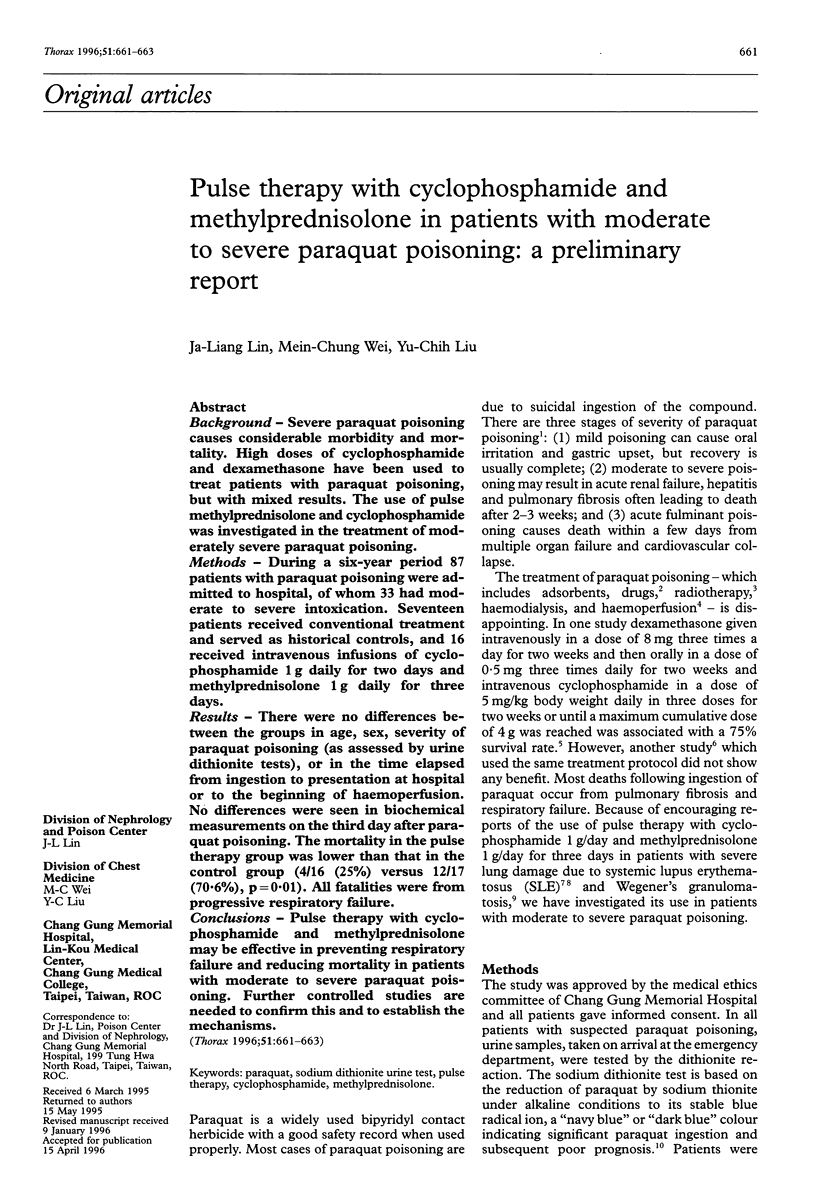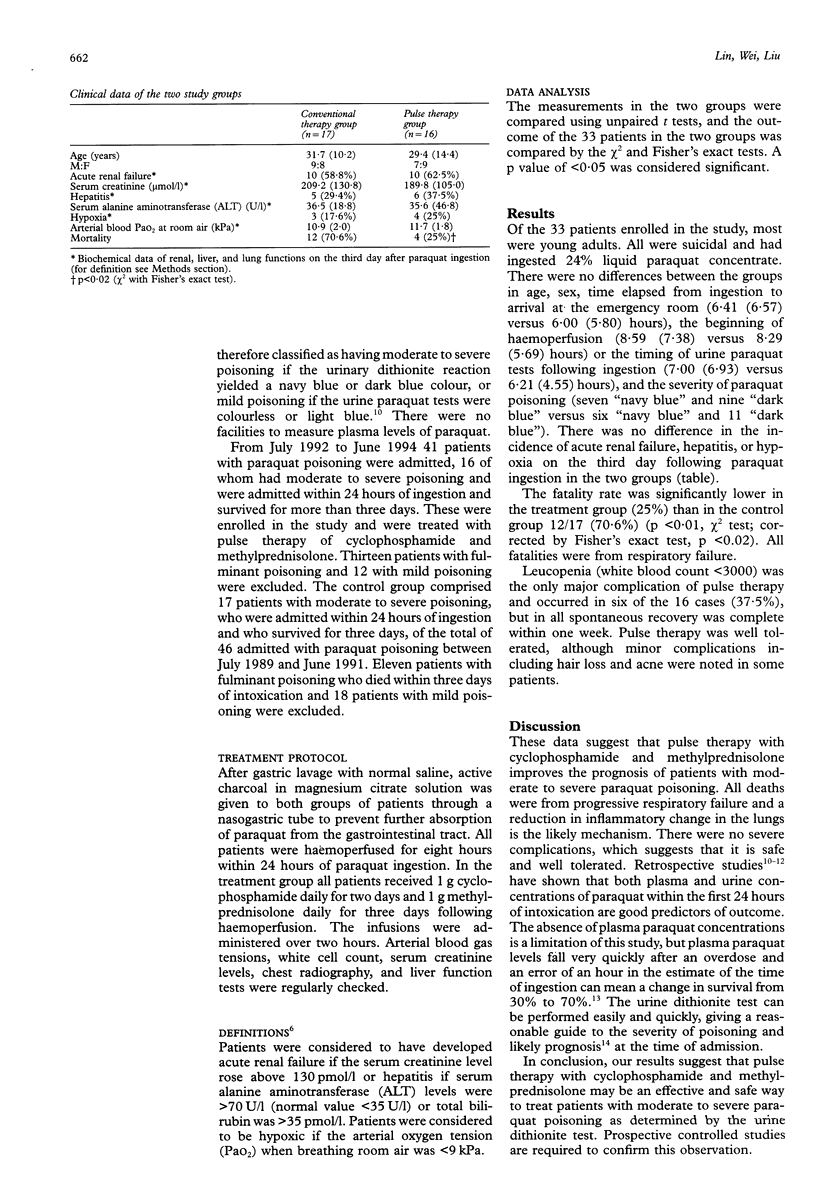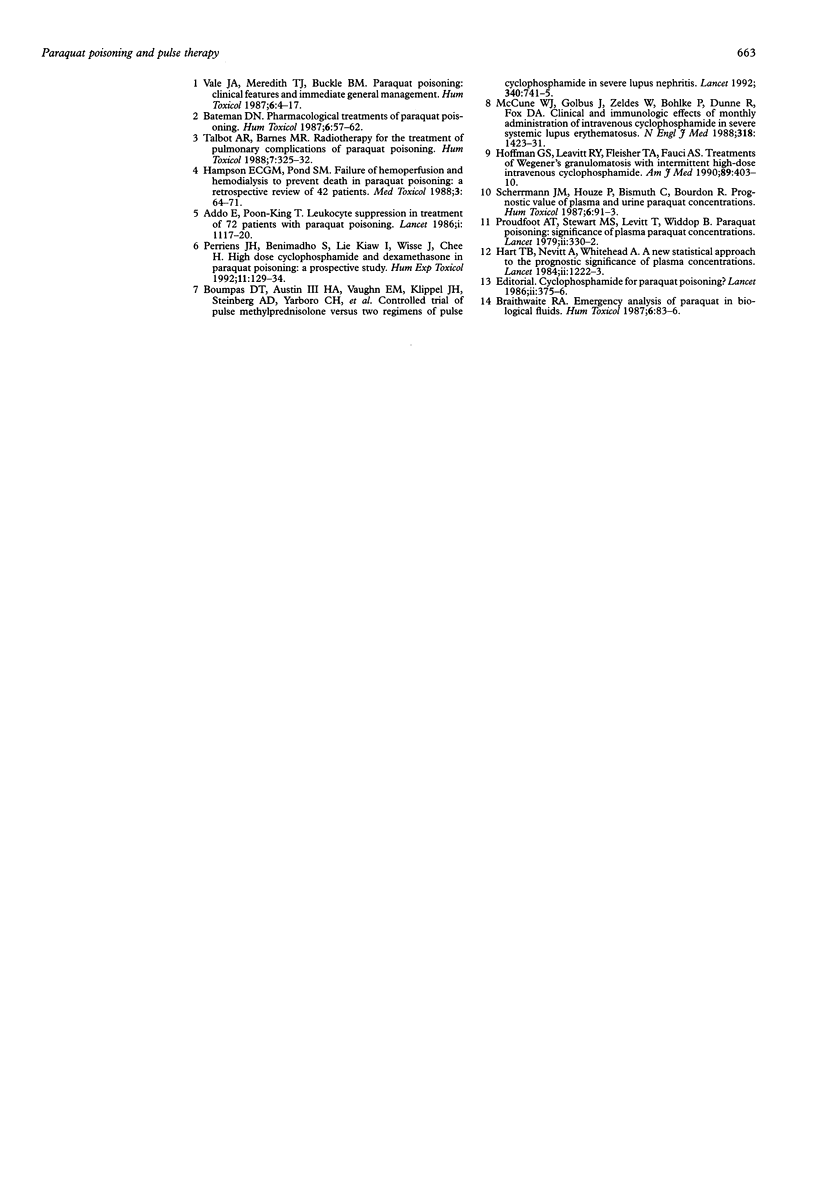Abstract
BACKGROUND: Severe paraquat poisoning causes considerable morbidity and mortality. High doses of cyclophosphamide and dexamethasone have been used to treat patients with paraquat poisoning, but with mixed results. The use of pulse methylprednisolone and cyclophosphamide was investigated in the treatment of moderately severe paraquat poisoning. METHODS: During a six-year period 87 patients with paraquat poisoning were admitted to hospital, of whom 33 had moderate to severe intoxication. Seventeen patients received conventional treatment and served as historical controls, and 16 received intravenous infusions of cyclophosphamide 1 g daily for two days and methylprednisolone 1 g daily for three days. RESULTS: There were no differences between the groups in age, sex, severity of paraquat poisoning (as assessed by urine dithionite tests), or in the time elapsed from ingestion to presentation at hospital or to the beginning of haemoperfusion. No differences were seen in biochemical measurements on the third day after paraquat poisoning. The mortality in the pulse therapy group was lower than that in the control group (4/16 (25%) versus 12/17 (70.6%), p = 0.01). All fatalities were from progressive respiratory failure. CONCLUSIONS: Pulse therapy with cyclophosphamide and methylprednisolone may be effective in preventing respiratory failure and reducing mortality in patients with moderate to severe paraquat poisoning. Further controlled studies are needed to confirm this and to establish the mechanisms.
Full text
PDF


Selected References
These references are in PubMed. This may not be the complete list of references from this article.
- Addo E., Poon-King T. Leucocyte suppression in treatment of 72 patients with paraquat poisoning. Lancet. 1986 May 17;1(8490):1117–1120. doi: 10.1016/s0140-6736(86)91836-2. [DOI] [PubMed] [Google Scholar]
- Bateman D. N. Pharmacological treatments of paraquat poisoning. Hum Toxicol. 1987 Jan;6(1):57–62. doi: 10.1177/096032718700600109. [DOI] [PubMed] [Google Scholar]
- Boumpas D. T., Austin H. A., 3rd, Vaughn E. M., Klippel J. H., Steinberg A. D., Yarboro C. H., Balow J. E. Controlled trial of pulse methylprednisolone versus two regimens of pulse cyclophosphamide in severe lupus nephritis. Lancet. 1992 Sep 26;340(8822):741–745. doi: 10.1016/0140-6736(92)92292-n. [DOI] [PubMed] [Google Scholar]
- Braithwaite R. A. Emergency analysis of paraquat in biological fluids. Hum Toxicol. 1987 Jan;6(1):83–86. doi: 10.1177/096032718700600113. [DOI] [PubMed] [Google Scholar]
- Hampson E. C., Pond S. M. Failure of haemoperfusion and haemodialysis to prevent death in paraquat poisoning. A retrospective review of 42 patients. Med Toxicol Adverse Drug Exp. 1988 Jan-Dec;3(1):64–71. doi: 10.1007/BF03259932. [DOI] [PubMed] [Google Scholar]
- Hart T. B., Nevitt A., Whitehead A. A new statistical approach to the prognostic significance of plasma paraquat concentrations. Lancet. 1984 Nov 24;2(8413):1222–1223. doi: 10.1016/s0140-6736(84)92784-3. [DOI] [PubMed] [Google Scholar]
- Hoffman G. S., Leavitt R. Y., Fleisher T. A., Minor J. R., Fauci A. S. Treatment of Wegener's granulomatosis with intermittent high-dose intravenous cyclophosphamide. Am J Med. 1990 Oct;89(4):403–410. doi: 10.1016/0002-9343(90)90367-m. [DOI] [PubMed] [Google Scholar]
- McCune W. J., Golbus J., Zeldes W., Bohlke P., Dunne R., Fox D. A. Clinical and immunologic effects of monthly administration of intravenous cyclophosphamide in severe systemic lupus erythematosus. N Engl J Med. 1988 Jun 2;318(22):1423–1431. doi: 10.1056/NEJM198806023182203. [DOI] [PubMed] [Google Scholar]
- Perriëns J. H., Benimadho S., Kiauw I. L., Wisse J., Chee H. High-dose cyclophosphamide and dexamethasone in paraquat poisoning: a prospective study. Hum Exp Toxicol. 1992 Mar;11(2):129–134. doi: 10.1177/096032719201100212. [DOI] [PubMed] [Google Scholar]
- Proudfoot A. T., Stewart M. S., Levitt T., Widdop B. Paraquat poisoning: significance of plasma-paraquat concentrations. Lancet. 1979 Aug 18;2(8138):330–332. doi: 10.1016/s0140-6736(79)90345-3. [DOI] [PubMed] [Google Scholar]
- Scherrmann J. M., Houze P., Bismuth C., Bourdon R. Prognostic value of plasma and urine paraquat concentration. Hum Toxicol. 1987 Jan;6(1):91–93. doi: 10.1177/096032718700600116. [DOI] [PubMed] [Google Scholar]
- Talbot A. R., Barnes M. R. Radiotherapy for the treatment of pulmonary complications of paraquat poisoning. Hum Toxicol. 1988 Jul;7(4):325–332. doi: 10.1177/096032718800700405. [DOI] [PubMed] [Google Scholar]


